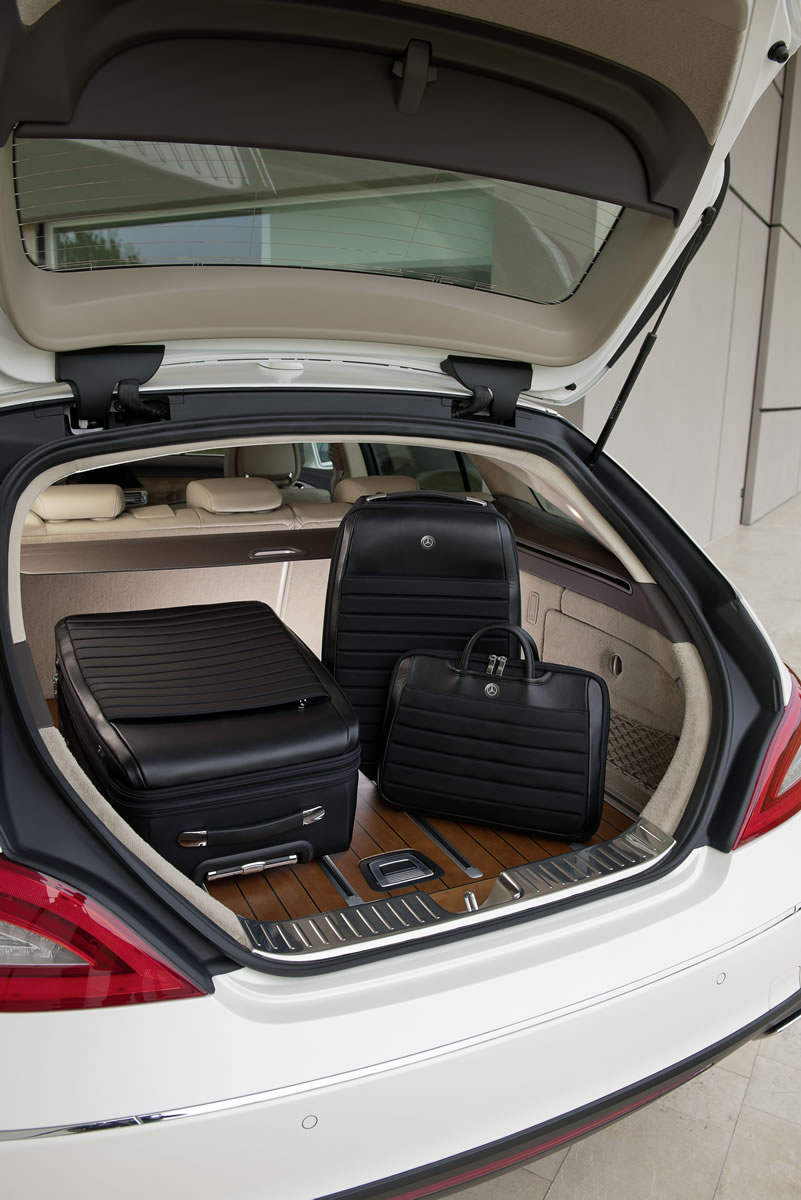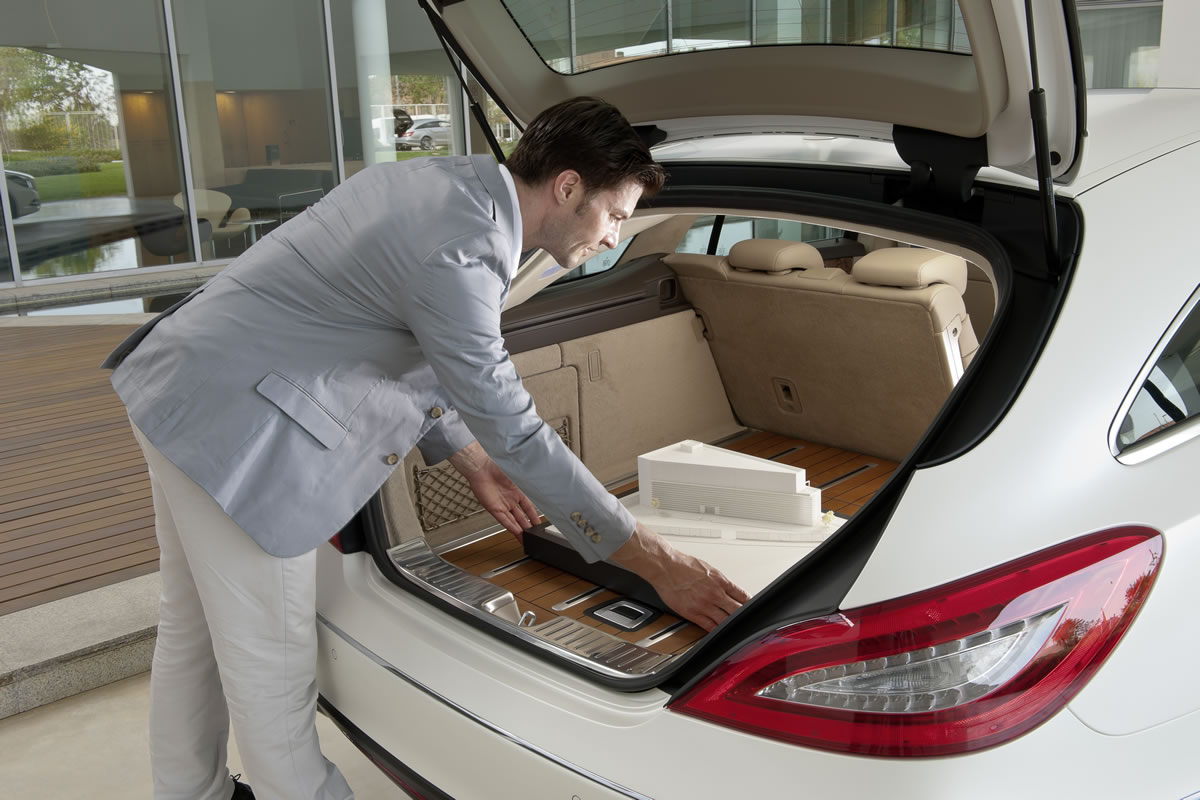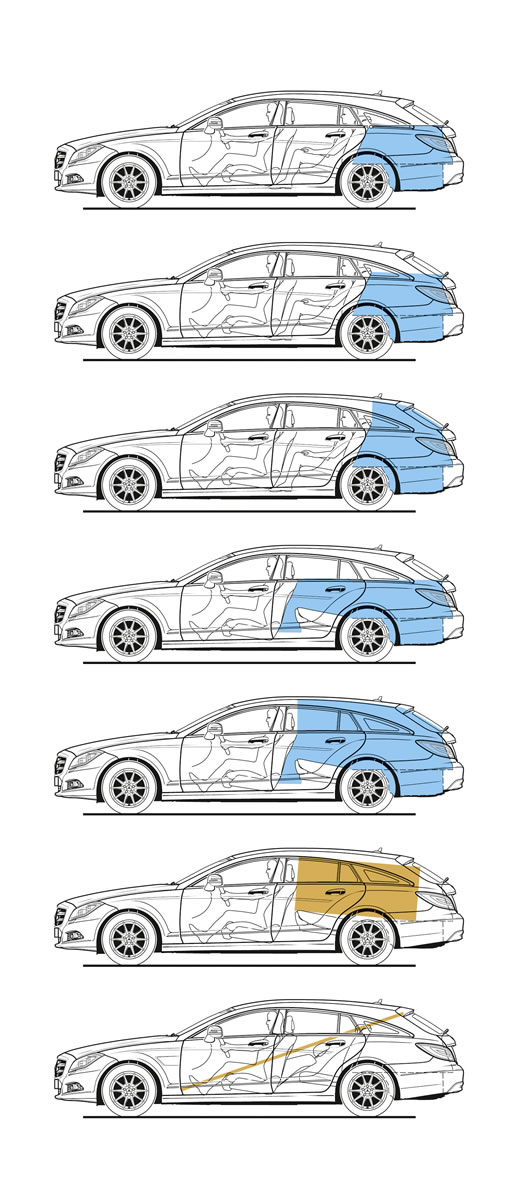While the Shooting Brake’s practical merits were not a prime consideration in its development, the new CLS model nevertheless has a number of utility benefits to offer in its stylish interior. Click here to view the 2013 CLS Shooting Brake exterior photo gallery.
With a load capacity of 590 to 1550 litres, the Shooting Brake’s luggage compartment offers plenty of space, despite the flat, sporty lines of the roof. The rear door opens automatically as standard to provide convenient access. A load compartment cover protects luggage from prying eyes. There is an additional spacious stowage compartment under the luggage compartment floor.
A particularly eye-catching feature inside the CLS is the three-spoke multifunction steering wheel in nappa leather with perforated inserts in the grip area, a silver-coloured chrome insert and twelve multifunction keys. The CLS Shooting Brake features the new lever positioning and the new lever design on the steering column: indicator and windscreen wiper for front and rear at top left, electric steering wheel adjustment/steering wheel heating centre left, cruise control with variable SPEEDTRONIC at bottom left and transmission selector lever at top right.
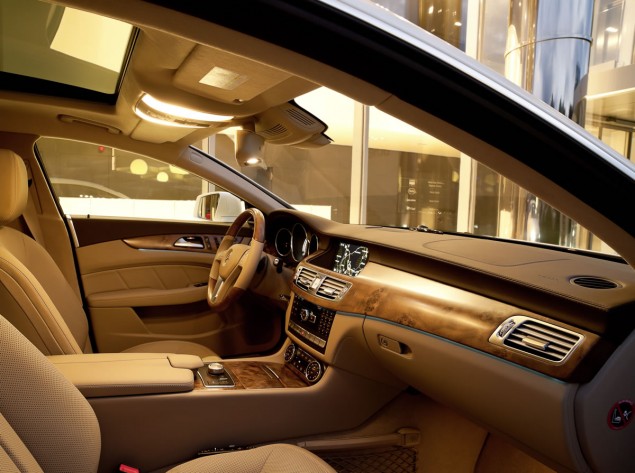
The highlight of the CLS instrumentation is the all-colour, three-dimensional TFT display in the middle of the speedometer, measuring 109 millimetres in diameter. The mileage and trip odometer appear in the upper area of the display, the bottom area displays – amongst other things – information from the driver assistance systems. A three-dimensional image of the vehicle appears when getting into or out of the CLS.
Three tube-shaped round dials in the cockpit inform the driver of the coolant temperature and fuel tank level (on the left), speed (in the middle) and engine rpm (on the right). A large colour display in 16:9 format, integrated into the upper part of the instrument panel support, gives information on all the infotainment functions. The TFT display (Active Matrix Thin Film Transistor), which is backlit with LED lights, uses so-called IPS technology. IPS stands for “in-plane switching”, which describes the shift direction of the liquid crystal. The benefit of this technology is that it displays high-contrast images. Depending on the specification, two versions of this display are available: a 14.7 cm version for the Audio 20 CD device and a high-resolution 17.7 cm variant for COMAND Online.
The centre console fits with the shape and colour of the instrument panel. The control unit for the infotainment system and the car telephone can be found underneath the analogue clock and air vents. The push-button switches for seat heating, seat ventilation, lowerable head restraints in the rear, PARKTRONIC and ECO start/stop function are arranged below this; they have been galvanised and are backlit. The large round control knobs for the automatic climate control, which is supplied as standard, are located in the lower part of the centre console. The controller in front of the armrest serves as the central control element for the infotainment systems and provides a quick and easy starting point for navigating the menus controlling the systems.
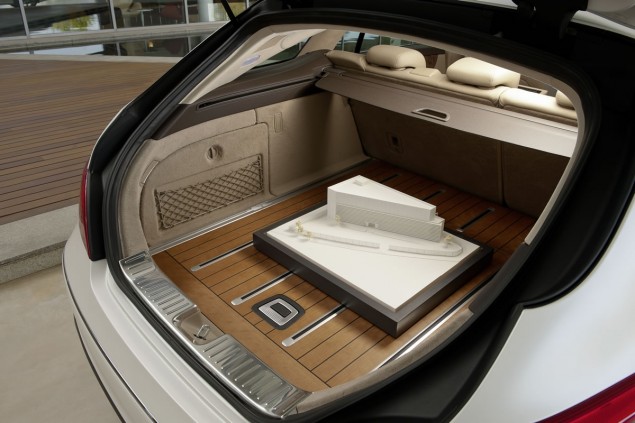
THERMOTRONIC climate control with three individual climate modes
The CLS 500, CLS 500 4MATIC and CLS 63 AMG are fitted as standard with an automatic climate control system which not only allows individual temperatures to be set for three zones – for the driver, the front passenger and the rear passengers – but additionally offers special climate modes. This means that if the optionally available THERMOTRONIC system is fitted, the car occupants can select “Diffuse”, “Medium” or “Focus” settings on the THERMOTRONIC at the push of a button and thus adjust the air quantity and air distribution to their liking without having to leave the convenient automatic mode.
In “Diffuse” mode, for example, the THERMOTRONIC system operates with a lower air speed and distributes the air over a wide area so that there are fewer draughts. This is the purpose of the automatically controlled, upwards inclined diffuse nozzle in the centre of the dashboard. In “Focus” mode, meanwhile, the air outlets in the centre area of the dashboard are used for the most part, meeting the need for a direct flow of a larger quantity of air. The standard system fitted in the CLS 250 CDI, CLS 350 CDI/CLS 350 CDI 4MATIC and CLS 350 is the two-zone THERMATIC automatic climate control. They are optionally available with THERMOTRONIC.

Seating comfort allowing adjustments to suit individual ergonomic needs
The seats in the CLS Shooting Brake combine seated comfort with lateral support.
There is a choice of four different front seats:
- The standard seat itself meets the highest ergonomic standards. Thanks to the filled seat piping, the feeling of comfort when getting into the vehicle is unique. A special upholstery technology is deployed here which inserts additional foam filling immediately beneath the cloth or leather upholstery. The front seats can be adjusted electrically as standard. The Memory package, which enables three individual settings to be saved, is available as an optional extra.
- The shape of the optional multicontour seat can be individually adjusted by and for the driver and passenger to fit their anatomy or to suit their personal wishes with regard to comfort. By adjusting the seat side bolsters, for example, the width of the backrest can be altered on both sides in a stepless operation by up to 45 millimetres, i.e. by up to 90 millimetres in total. Other bonuses of the multicontour seat include the pneumatic height adjustment facility for the seat cushion, the four-way lumbar support and the high-comfort head restraints.
- The active multicontour seat offers the same comfort functions and features a massage function covering seven zones and two stages as well as vehicle dynamics support: high-speed piezo valves in the air chambers which adjust the charging pressure and volume of the air chambers in the side bolsters of the seat backs, depending on the steering angle, lateral acceleration and vehicle speed, to provide even greater support.
- Climate comfort is further enhanced by the optionally available climatised seats: four ventilators in the seat cushion and in the backrest extract cool air from the floor area of the interior and distribute it evenly through a ventilation tissue beneath the seat surface. The mild airflow can prevent the car’s occupants from sweating, even when it is extremely hot outside.
- The rear seating comprises three seats with ergonomically shaped individual outer seats and backrests with a 1/3 2/3 split. The backrests can be released from the luggage compartment by means of handles on the D-pillar. When the backrests are released they fold down automatically and the head restraints are lowered by their own weight onto the backrests, enabling them to be folded down together with the backrests. The rear-seat backrests are fitted with three head restraints designed for optimum visibility, whereby the two outer head restraints are height- and tilt-adjustable.
The driver can lower the head restraints to their bottom position at the touch of a button. They are lowered by the force of their own weight. The rear seat covers incorporate four filled flutes for a high level of seated comfort and offer particularly good lateral support. The “heated rear seats” option is available in conjunction with leather upholstery. The two outer rear seats can be heated separately. The controls for the rear seat heating are located in the panelling of the rear doors.


